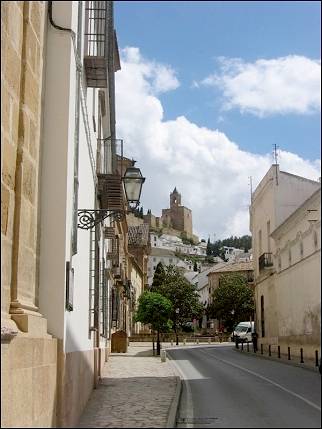
|
Culture and Nature
in Andalusia
White Villages in Pretty Mountainscapes With Unspoilt Nature
Andalusia has plenty to offer for a month-long tour. So it is a big challenge to see the highlights in just a week and find a balance between culture and nature. We explore the south-west of the province from two operating bases: Antequera (north of Malaga) and Montellano (south of Sevilla). We visit Granada and Sevilla, and also Ronda, El Torcal and a series of white villages.
Travelogue & photos: Luk Carion
After a gloomy winter and wet spring the lure of the sun is strong: a trip to Andalusia, an unknown region for us, but the prospect of nice and warm weather is enough of an incentive to plan this trip. We face a huge challenge: to see the highlights of Andalusia in just a week, and to find a balance between culture and nature, between exertion and relaxation.
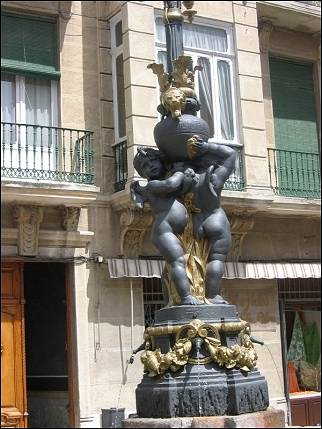
|
Preparing for a trip is already traveling: we book two hotels, a rental car, and the flights via internet. We read travelogues and then... after the gloomy days are over, we leave for the sunny south in mid-May.
After a two-and-a-half hours flight from Brussels to Malaga, we find ourselves to our surprise in gloomy weather. It even rains. First we pick up our rental car, and we are lucky: instead of a Peugeot 206 we get a Ford C-Max Diesel - a space wagon - for the same price.
It soon becomes clear that Spaniards are nervous drivers: everyone is honking all the time, but we'll get used to that. There are many new roundabouts which aren't mentioned yet on our PDA-route planner: sometimes traffic on the roundabout has right of way, sometimes it doesn't. It is confusing.
We have to get used to the narrow streets: it's best to leave your car in a parking lot when visiting cities. Don't risk parking in the centers of villages. We have seen countless damaged side mirrors and scratches, not to mention punctures: the high curbs will certainly rip your tires.
Antequera
A centuries-old city dominated by a Moorish fortress
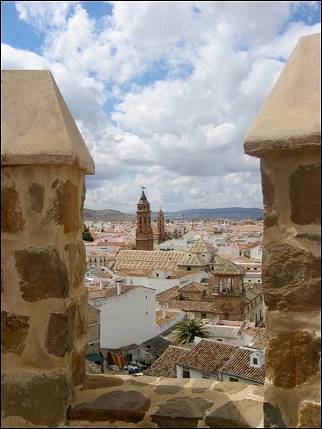
|
We take the highway to Antequera, our first destination, where we will spend three nights. On the way from Malaga we are amazed by the huge olive groves. Our hotel in Antequera is simple, but well-cared for, for less than 40 euros a night. Andalusia in general looks well tended.
Antequera is, as its name suggests, an ancient city, which is dominated by the Alcazaba (Moorish fortress), from where you have a great view of the city and its surroundings. It is also fun to wander in the city, visit a monastery or the arena where bullfights are held; it also has a (free) museum.
After our exhausting trip we want to have dinner in the evening. It turns out that we are the first guests in the restaurant at 8 PM, and we are kindly requested to come back after at least half an hour. Spaniards usually have dinner after 9 PM: only then the city gets lively.
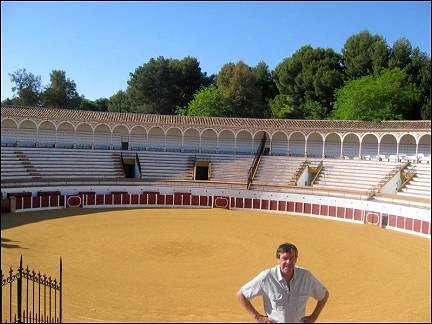
|
It is a bit late for us so we find a solution: we have our main meal at lunchtime and have only some tapas in the evening, which is sufficient. In any case: the food is always tasty, nicely presented and apparently also prepared in a sanitary way. The portions are very large, so think twice before having a first course.
Granada
The Alhambra is very impressive
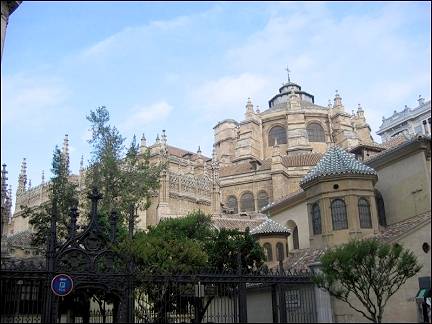
|
You can't visit Andalusia without a visit to Granada. After an 80 kilometers drive we park our car in a paid-parking lot. You should do this in every city, your car is safe and not too far from the city center.
The weather looks a little better, but we won't get to see the sun today. In hindsight, this is perfect for a city visit.
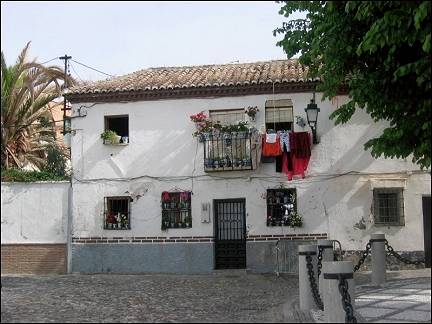
|
The cathedral (which has very limited opening hours and charges an entrance fee) is a dwarf in comparison with the one in Sevilla, but the royal chapel next to it has free entrance and a very interesting sixteenth century choir screen and a beautiful retable.
We continue on foot to the Albaicín, the Moorish district: a maze of narrow streets on a hill opposite the Alhambra hill. From the St. Nicholas mirador we have a splendid view of the Alhambra.
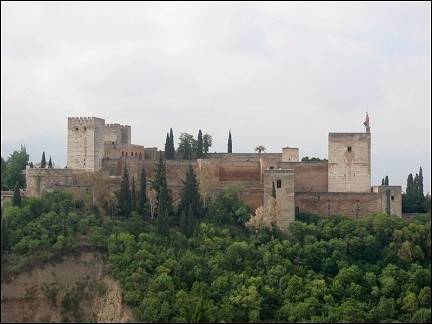
|
We already knew that the daily number of visitors is limited for the Alhambra, so we booked tickets on the internet, which turned out to be a huge mistake: according to the web site there only were some tickets left for 7 PM. But on the spot we find out that there are still tickets for several slots in the afternoon.
So buy your tickets on the spot (go in the morning when the Alhambra opens for visitors), especially outside the tourist season. In the month of May it wasn't really crowded anywhere. We have walked a lot of miles today, so we take the bus (#32-31) up. The Alhambra is very impressive, a gigantic Moorish fortress.
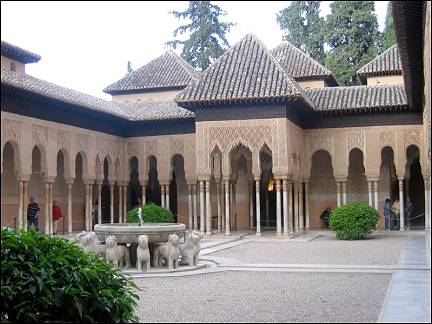
|
The palaces are unforgettable. The gardens (Generalife), which are also called beautiful in the travelbooks, are a little disappointing to us as flower and plant lovers. Because we have so much time - another two hours before we can enter the palaces themselves - we can take a nap on one of the many benches in the Generalife by a brook or a fountain.
The fountains and waterfalls sound better than they are, though. We don't know why, but hardly any of the fountains function. It was the same in Sevilla: lack of water? In any case, the Alhambra is a "must see" for which you should take half a day. Our feet hurt in the evening: both Albaicín and Alhambra have cobblestone paths: sandals were not a good idea, bring sturdier shoes.
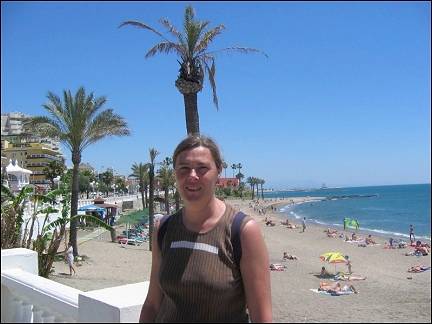
|
A day of rest on the beach... or so we think. So we drive towards Malaga and then west along the Mediterranean, past Torremolinos because we are not interested in crowded beach resorts. We arrive in a town past Torremolinos, which turns out to be just as crowded: loud Brits, shops, a busy coastal road... a bummer.
After an hour we've had it and drive back to Antequera via secondary roads and little villages. Maybe it would have been better to look east of Malaga. Or twenty kilometers farther, as we will find out on our last day.
El Torcal and Ronda
Interesting rock formations and a city on the edge of a canyon
A few kilometers south-east of Antequera lies the natural phenomenon of El Torcal: limestone mountains which have been shaped into bizarre formations by erosion.
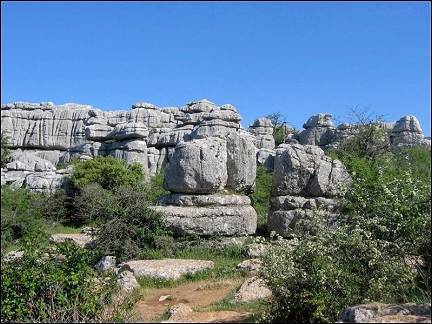
|
The route to the visitors center goes over a narrow road all the way to the top and offers wonderful views. We park the car and take the "green" hiking trail to see the nature reserve. It's a one hour walk on paths with road signs and great views of the interesting rock formations.
A few eagles circle above us in the blue sky. Plant life is varied: it is clear that this area gets more rain than the coast or the inland.
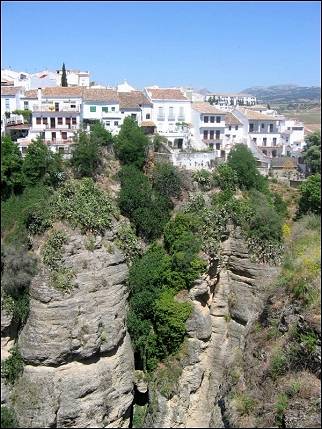
|
Our second hotel is in Montellano. Our first visit is to the universally recommended town of Ronda, which lies on our way to Montellano. Our first impressions are disappointing: a relatively large town and we have to walk a great distance to get to the historical town center.
But the visit to the old city makes up for a lot. We wander through narrow streets along the city walls. A deep, steep canyon, Tajo, separates the old from the new city. Houses hang like swallow nests on to the edge of a 200 meters deep abyss. A giddy bridge spans the canyon. It's all very beautiful.
In this city, Andalusia also strikes us as very quiet. Could it be that the month of May is perfect for this trip? Still they know how to rip off tourists: 6 euros for two drinks; in the countryside it would be less than 2 euros.
Montellano and the Pueblos Blancos
White villages in a lovely mountainscape with unspoilt nature
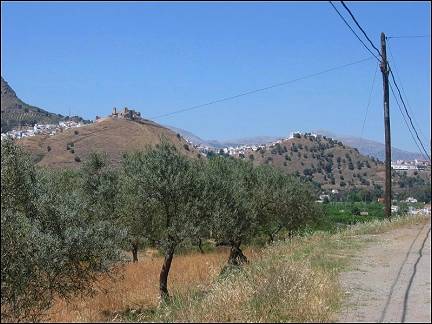
|
Montellano is a quiet and peaceful village, perfect as an operating base for Sevilla and the Pueblos Blancos. These "white villages" are all located in a lovely mountainscape with unspoilt nature. They are witnesses of the Moorish past. Obviously, they are bright white, and have narrow, winding streets.
There even is a Pueblos Blancos Route, but it would take several days. We have to limit ourselves to a selection.
Arcos de la Frontera is not only the first village on our route, but also the largest and therefore less charming as far as we are concerned.
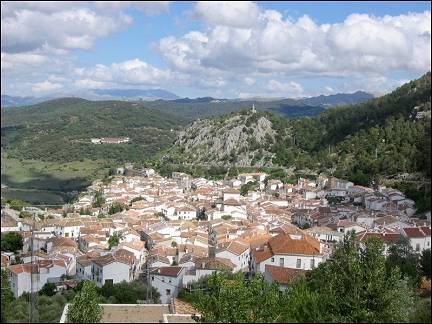
|
We walk through its streets until a short rainshower forces us to take shelter in a bar where we have some tapas. We decide to drive to the next village, El Bosque. This one is more like a village, but doesn't appeal to us either. Could it be the gloomy weather today?
We take the A372 to Grazalema, which is a white village that deserves this name. It is probably one of the most picturesque of all white villages. It also is the wettest village in Spain. Because of the condensation of warm clouds in the mountains, this area has a lot of precipitation. We wander through the narrow streets, enjoy the wonderful views and have a drink in the local bar. Time has stood still here. In the past, Grazalema was a textile center but nothing reminds of that.
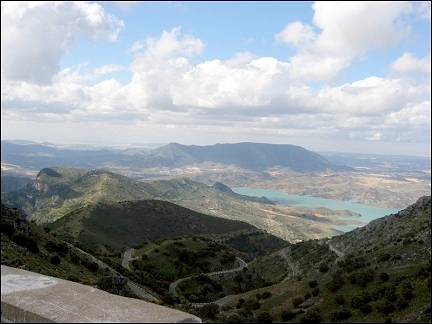
|
We take the CA531 from Grazalema and cross the spectacular mountain pass Puerto de las Palomas to Zahara de la Sierra. The route takes us high into the mountains and we find ourselves in the clouds at some point. After that, the views of the Sierra de Grazalema and surroundings are fantastic.
The descent to Zahara (hairpin turns) takes a lot of steering skill, but but we are rewarded with a magnificant view of the huge reservoir Embalse de Zahara. This narrow road may not be suitable for people with vertigo, but it is definitely recommended if you want to see the Sierra. We take a look at the surroundings from a mirador, eagles float high up in the air. The natural beauty of this place is indescribable.
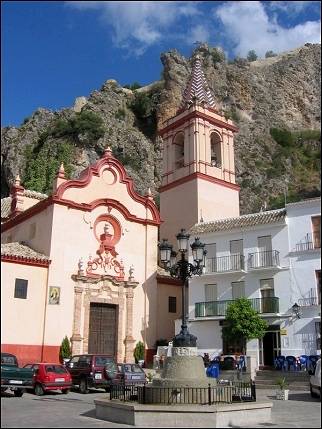
|
After our descent we arrive in Zahara, as far as we are concerned the most beautiful pueblo. We park our car at the entrance of the village and take a walk in its main street. The sun is back, too, and everything is more colorful and has more depth. The white of the houses sometimes hurts our eyes!
At the very end of the street is a lively square with a fountain and outdoor cafés. We sit down and enjoy everything around us. By the way: you won't find many outdoor cafés in the pueblos, people retreat to the coolness of their houses, which keep the heat out with their thick walls (and air conditioning).
Sevilla
The green capital of Andalusia
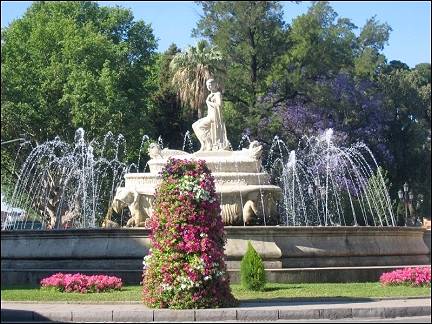
|
60 kilometers north of Montellano lies Sevilla. The road to it leads through a Tuscan looking landscape: rolling hills, overgrown with grain (the Sevilla region is Spain's grain silo), sunflowers and olives.
Also in Sevilla it's best to park your car in a garage; we do this near the Isable II bridge, in Parking Colon, only a few minutes on foot from the historic center.
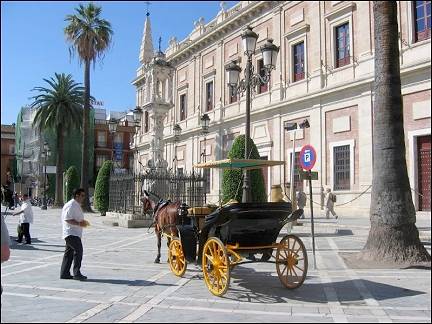
|
Sevilla is much greener than Granada, there are more parks and (palm)trees. This probably has to do more with the soil than with the temperature: Sevilla is nicknamed "the frying pan of Spain."
You can easily spend a few days in this city. But we have to limit ourselves to the highlights: the Gothic cathedral (very pretty, both inside and out); the tower of the cathedral (Giralda, originally a minaret that was part of a mosque), which will offer you a unique view of the whole city if you climb up to the belltower; Barrio de Santa Cruz (former Jewish district) with its narrow streets; Alcazar with its palaces; Torro del Oro (Moorish defense tower, also used to store goods from ships coming in from overseas, which explains the name "Golden Tower"); and the Spanish Square. It's all pretty and interesting and more than worth a visit.
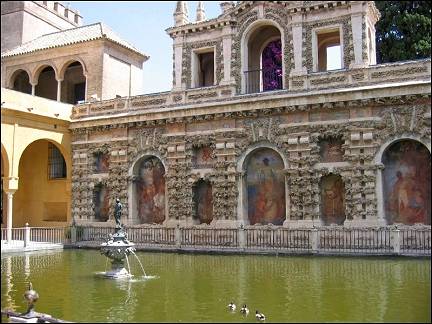
|
We decide to take a look on the other side of the canal: on the Puente Isabel II are outdoor cafés, with great views of historic buildings. We rest our feet. On the way back to our car we have ice cream: it's almost 30 degrees centigrade by now.
Pueblos Blancos
Many flowers along the path
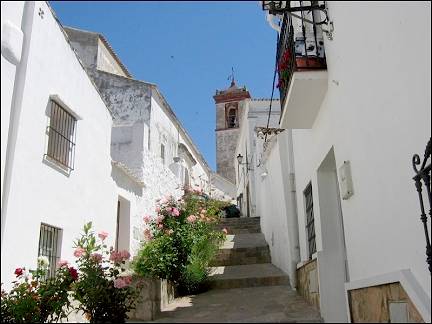
|
We can't get enough of them: after our visit to the big city Sevilla we drive to the mountains and pueblos blancos again. Via Ubrique, which looks too big to charm us, to Benocaz, which is located beautifully on a slope.
We walk to the upper part of the village and find the over 300 years old remains of the original village. From there the path leads to a chapel with Stations of the Cross. It offers a nice view of the village. There are many flowers along the path.
From Benocaz we take a beautiful route to Villaluenga del Rosario, a peaceful village that hasn't yet been discovered by tourists. It has a church on a square which is beautifully planted with trees. Some old villagers sit on benches and chat. A little farther we find the bullfight arena, built against a mountain side.
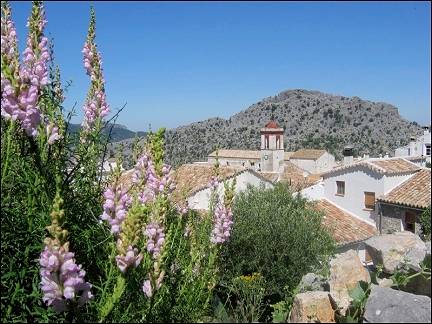
|
There is a café on the square and we decide to quench our thirst there. An elderly lady waits on us. We ask (or rather gesture) if there is food and she answers us with an affirmative nod. The food is tasty: chicken and rabbit and it's all very cheap.
When it comes to food and drinks we avoid the tourist centers and go where the Spaniards go. It's the best way to get good food for little money.
On our last day we drive back to Malaga, 160 kilometers. We take a beautiful road via Rona to San Pedro, the A376, which also has a great view of the Mediterranean. We still have time to go to the beach and sit in the sun. There are still small beach resorts here, far away from mass tourism. We enjoy the steel-blue sky and the heat of the sun on more time.